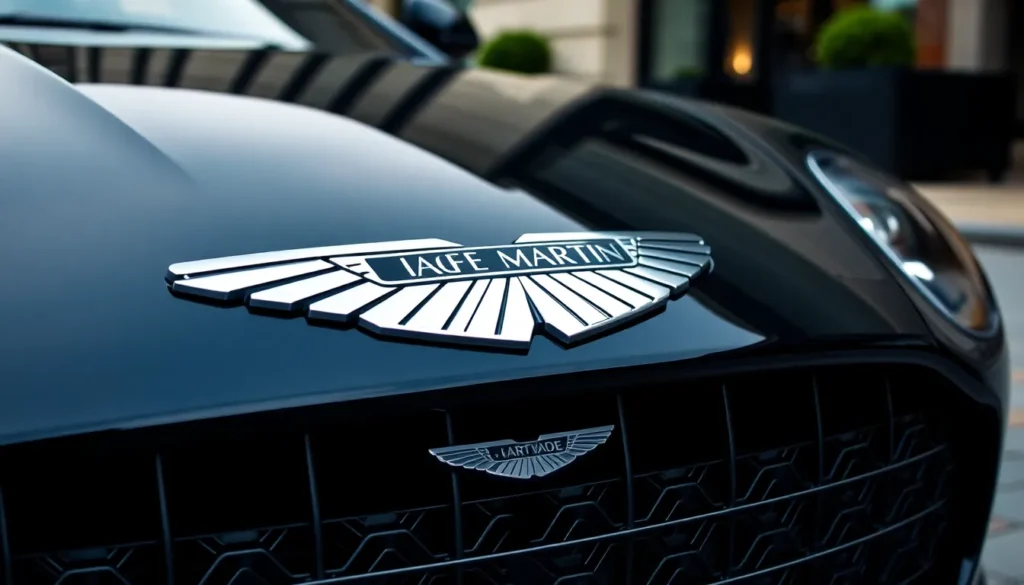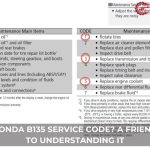When we think of luxury automotive excellence, few symbols command as much respect and admiration as the Aston Martin logo. This distinctive winged emblem has graced some of the industry’s most coveted supercars for over a century, becoming synonymous with British craftsmanship and unparalleled sophistication.
The iconic wings that define Aston Martin’s visual identity aren’t just decorative elements – they’re a powerful representation of speed, freedom, and the brand’s racing heritage. From James Bond’s legendary DB5 to today’s cutting-edge Vantage models, this emblematic logo has evolved while maintaining its timeless appeal.
We’ve witnessed countless automotive brands come and go, but Aston Martin’s logo remains one of the most recognizable and prestigious symbols in the industry. Understanding its rich history and symbolic meaning reveals why this British marque continues to captivate enthusiasts and collectors worldwide, representing the perfect fusion of luxury, performance, and automotive artistry.
The History Behind the Aston Martin Logo
The Aston Martin logo traces its origins back to 1913 when Lionel Martin and Robert Bamford founded the company. This iconic emblem emerged from a passionate vision that would eventually transform into one of the automotive industry’s most recognizable symbols.
From Humble Beginnings to Luxury Icon
Our understanding of the Aston Martin logo’s genesis begins with Lionel Martin’s racing exploits at Aston Hill Climb in Hertfordshire. The company name combined Martin’s surname with the Aston Clinton hill climb location where he achieved notable racing success in 1914. Early Aston Martin vehicles featured simple script lettering rather than the distinctive winged badge we recognize today.
The transformation from basic typography to luxury iconography occurred gradually during the 1920s. Aston Martin adopted the winged motif to represent speed and aviation excellence, reflecting the era’s fascination with flight technology. This design philosophy connected the brand’s automotive engineering with the cutting-edge aviation industry of that period.
Racing heritage significantly influenced the logo’s development as Aston Martin established its reputation at Le Mans and other prestigious competitions. The wings symbolized the brand’s aspirations to soar above conventional automotive boundaries, creating vehicles that merged performance with elegance.
Evolution Through the Decades
We observe distinct phases in the Aston Martin logo’s transformation from the 1930s through present day. The 1930s introduced the familiar winged scarab design with “Aston Martin” text positioned centrally within the wings. This configuration remained relatively stable through the post-war period when David Brown acquired the company in 1947.
The David Brown era (1947-1972) refined the logo’s proportions and enhanced its three-dimensional appearance. DB models like the legendary DB5 featured evolved wing designs with improved aerodynamic styling that complemented the vehicles’ sleek profiles. Chrome applications and precise craftsmanship elevated the badge’s premium aesthetic during this golden age.
Modern iterations since the 1980s have maintained the essential winged structure while incorporating contemporary design elements. Digital precision replaced hand-crafted techniques, allowing for consistent reproduction across all brand applications. The logo’s color palette evolved from simple chrome finishes to sophisticated combinations including black, silver and green accents that reflect Aston Martin’s British racing heritage.
Recent decades have seen subtle refinements rather than dramatic overhauls, preserving the logo’s timeless recognition value while adapting to modern manufacturing processes and brand guidelines.
Design Elements of the Aston Martin Logo
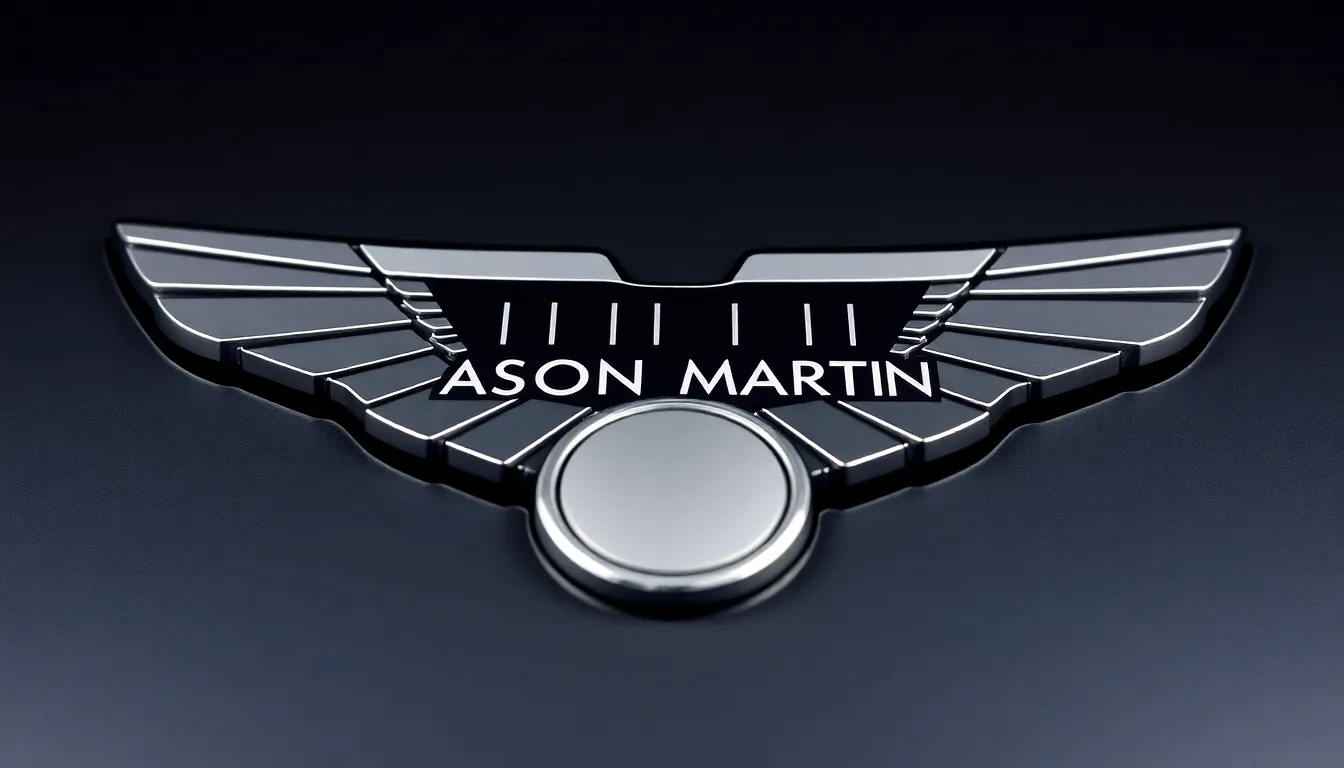
The Aston Martin logo features carefully crafted design elements that create visual harmony and brand recognition. Each component works together to establish the badge’s distinctive luxury automotive identity.
The Iconic Wings Symbol
Wings represent the core visual element of the Aston Martin emblem, stretching horizontally across the badge’s width. The symmetrical wing design contains precisely detailed feathers that create depth and texture through graduated layering. Each wing features multiple feather sections that taper from the outer edges toward the central circle, mimicking authentic bird wing anatomy.
Aircraft inspiration influenced the wing structure during the 1920s development period, connecting the design to aviation excellence and speed. The wings extend beyond the circular center element, creating a ever-changing sense of motion even when stationary. Modern iterations maintain the feathered texture while incorporating cleaner lines that enhance visibility across different vehicle surfaces and marketing materials.
Typography and Color Scheme
Typography within the Aston Martin logo uses custom lettering that appears exclusively in the central circular section. The wordmark “ASTON MARTIN” curves along the inner circle’s perimeter using serif-style characters with classic proportions. Letter spacing maintains consistent intervals that ensure readability at various scales from small badges to large dealership signage.
Color application typically features metallic silver or chrome finishes that reflect the brand’s premium positioning in the automotive market. The monochromatic approach creates versatility across different vehicle paint colors while maintaining brand consistency. Black backgrounds often accompany the silver elements in digital applications, providing contrast that enhances the logo’s visibility and impact.
Proportions and Geometric Balance
Geometric relationships govern the logo’s proportional system, with the central circle occupying approximately 40% of the total emblem width. The wings extend symmetrically on both sides, creating a total width-to-height ratio of roughly 3:1 that produces horizontal emphasis. This proportion enables optimal integration into vehicle grilles, steering wheels, and other automotive surfaces.
Mathematical precision ensures each wing contains identical feather counts and spacing measurements that maintain perfect symmetry. The circular center element positions exactly at the emblem’s midpoint, creating visual stability and balance. These proportional standards remain consistent across all applications, from physical badges measuring 150mm in width to digital versions appearing on mobile devices at 30 pixels wide.
Symbolism and Meaning of the Aston Martin Logo

The Aston Martin logo carries profound symbolic meaning that extends beyond mere brand identification. Each design element reflects the company’s core values of performance, heritage, and automotive excellence.
Wings as a Representation of Speed and Freedom
Wings dominate the Aston Martin logo as the primary symbol of velocity and liberation from earthly constraints. These aerodynamic elements draw inspiration from aviation’s golden age during the 1920s, when aircraft represented humanity’s ultimate achievement in speed and technological advancement. The feathered wing design creates visual motion even when stationary, suggesting the perpetual movement and ever-changing energy characteristic of Aston Martin vehicles.
Speed becomes tangible through the horizontal sweep of the wings, which mirror the airflow patterns over high-performance automotive surfaces. The wingspan extends beyond the circular badge boundaries, creating an impression of breaking free from limitations. Freedom manifests in the upward trajectory of the wing tips, symbolizing the brand’s ability to transcend conventional automotive boundaries through innovative engineering and design excellence.
Each feather detail within the wings represents precision craftsmanship, reflecting the meticulous attention to detail found in every Aston Martin vehicle. The symmetrical wing structure conveys balance between power and control, essential characteristics for both aviation and high-performance driving experiences.
The Connection to British Heritage
British identity permeates every aspect of the Aston Martin logo through deliberate design choices that honor the nation’s automotive legacy. The wings themselves reference the Royal Air Force’s influence on British culture, particularly during periods when aviation represented national pride and technological superiority. This connection reinforces Aston Martin’s position as a quintessentially British luxury brand with deep cultural roots.
Craftsmanship traditions from British manufacturing appear in the logo’s refined typography and balanced proportions. The serif-style lettering echoes classic British design principles found in traditional signage and architectural elements throughout England. These typographical choices distinguish Aston Martin from international competitors while maintaining sophisticated elegance.
The logo’s metallic finishes reflect Britain’s industrial heritage, particularly the nation’s expertise in metallurgy and precision engineering. Chrome and silver treatments mirror the polished components found in British luxury goods, from fine watches to bespoke automotive accessories. This material connection reinforces the brand’s commitment to traditional British manufacturing values while embracing contemporary production techniques.
Royal connections emerge through the logo’s heraldic qualities, resembling coat of arms designs used by British nobility and institutions. The circular badge format follows traditional British automotive emblems, creating visual consistency with other prestigious British marques while maintaining distinct Aston Martin characteristics.
Logo Variations Across Different Models
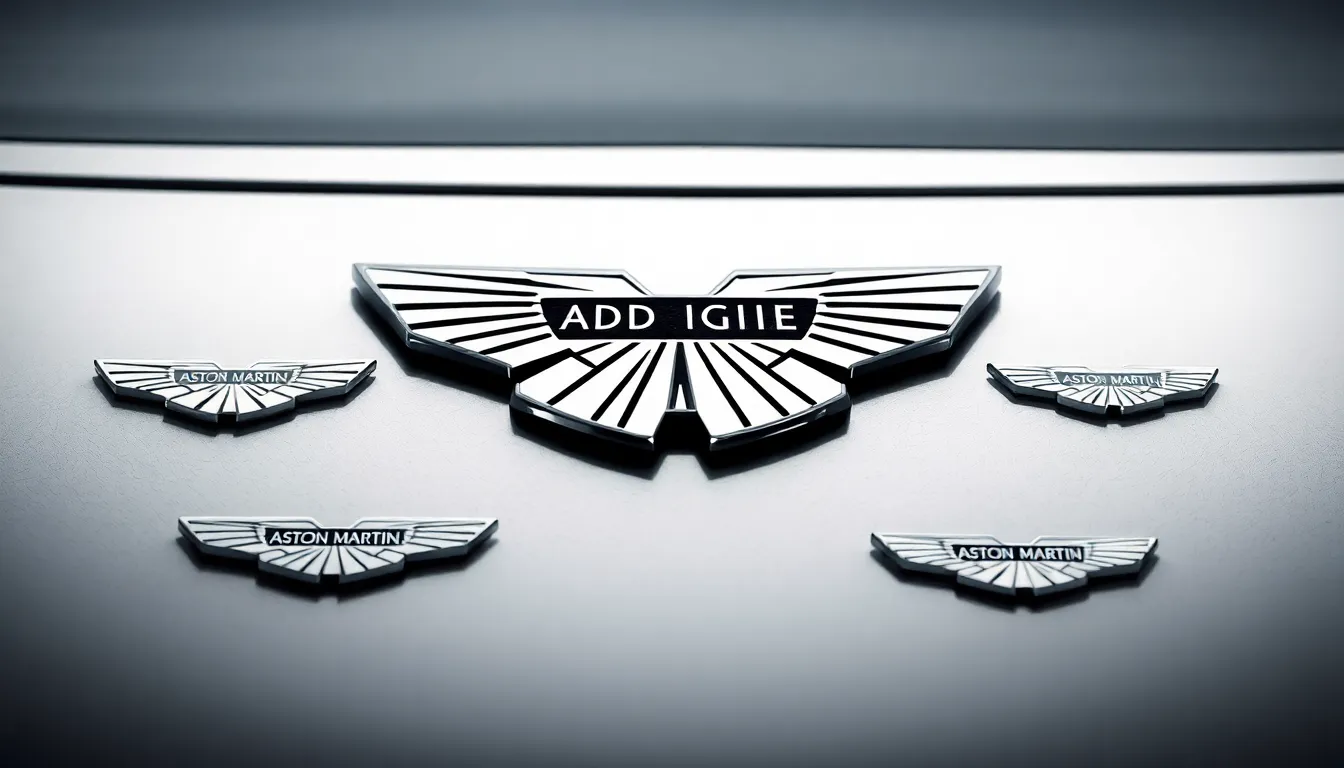
Aston Martin adapts its iconic winged logo across different vehicle categories while maintaining the core design integrity that defines the brand. Each model category features exact logo treatments that reflect the vehicle’s character and intended market position.
Standard Production Vehicles
Standard production models like the DB11, Vantage, and DBS feature the classic Aston Martin wings badge with polished chrome or brushed aluminum finishes. These vehicles display the logo prominently on the front grille, steering wheel center, and key fob with consistent proportions measuring approximately 150mm width on the grille placement.
Contemporary models incorporate LED backlighting behind the grille logo on select trim levels, creating an illuminated effect during evening hours. The badge sits flush with the grille surface and uses advanced mounting techniques that eliminate visible fasteners, maintaining the clean aesthetic lines that characterize modern Aston Martin design.
Wheel center caps on standard models feature a reduced version of the wings logo, typically measuring 65mm in diameter with simplified wing details to ensure readability at the smaller scale. Interior applications include embossed leather headrests, floor mat logos, and dashboard trim pieces that showcase the brand identity throughout the cabin experience.
Limited Edition and Special Models
Limited edition vehicles like the Victor, Valour, and anniversary models receive unique logo treatments that distinguish them from standard production cars. These special editions often feature gold plated or titanium finished badges that reflect the exclusive nature of the limited production runs.
Commemorative models frequently incorporate special colorways within the logo design, such as Union Jack elements for British heritage editions or racing inspired accents for track focused variants. The One-77 hypercar featured a distinctive carbon fiber wing design integrated directly into the body panel rather than as a separate badge element.
Anniversary models celebrate exact milestones with numbered plaques positioned adjacent to the standard logo placement. These editions might include engraved production numbers, special edition names, or commemorative dates that add historical significance to the vehicle’s visual identity.
Racing and Performance Variants
Racing variants like the Vantage GTE and AMR models feature aerodynamically optimized logo treatments that reduce drag while maintaining brand recognition. These competition vehicles often use lightweight decal applications instead of metal badges to minimize weight impact on vehicle performance.
Track focused models incorporate the AMR (Aston Martin Racing) designation alongside or replacing the traditional wings logo in certain applications. The AMR logo features angular design elements that reflect the aggressive nature of performance oriented vehicles while maintaining connection to the parent brand identity.
Competition vehicles display sponsor logos and racing series badges alongside the Aston Martin identity, requiring careful placement strategies that preserve brand prominence. Professional racing cars often feature enlarged wing logos on the hood or roof sections to ensure television broadcast visibility during motorsport events.
Comparing Aston Martin Logo to Competitors
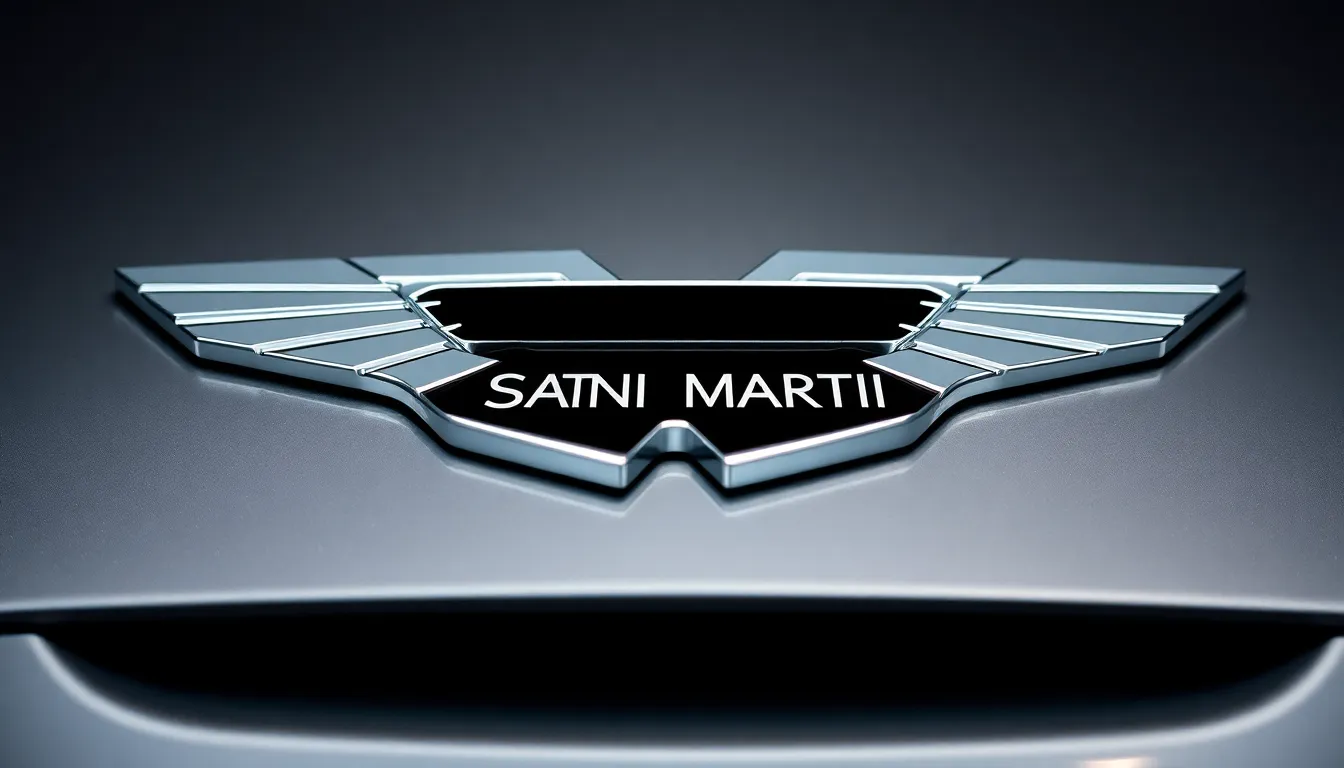
We examine how Aston Martin’s winged emblem stands against other prestigious automotive marques in the luxury segment. The competitive industry reveals distinct approaches to brand identity that reflect each manufacturer’s heritage and values.
Luxury Automotive Brand Logos
Ferrari’s prancing horse commands instant recognition through its bold black stallion on a yellow shield background. The Italian marque draws inspiration from Industry War I fighter pilot Francesco Baracca, creating emotional connections through military aviation heritage.
Bentley employs a winged “B” design that shares aviation themes with Aston Martin yet maintains distinctly different execution. Their wings curve upward in a more pronounced arc, while chrome detailing emphasizes British luxury craftsmanship through refined metallurgy.
Lamborghini’s charging bull represents raw power and aggression, contrasting sharply with Aston Martin’s elegant wing motif. The Spanish fighting bull symbolizes untamed performance, appealing to drivers seeking dramatic visual statements.
Rolls-Royce features the Spirit of Ecstasy hood ornament alongside their interlocked “RR” monogram. Their approach combines three-dimensional sculptural elements with traditional typography, creating layered brand recognition systems.
Maserati’s trident draws from Neptune’s weapon, connecting the brand to Bologna’s Fountain of Neptune. The three-pronged spear creates vertical emphasis, differing from Aston Martin’s horizontal wing spread.
| Brand | Logo Type | Primary Symbol | Color Scheme |
|---|---|---|---|
| Aston Martin | Wings | Spread eagle wings | Silver/Black |
| Ferrari | Shield | Prancing horse | Red/Yellow |
| Bentley | Wings | Winged letter B | Chrome/Black |
| Lamborghini | Shield | Charging bull | Gold/Black |
| Rolls-Royce | Monogram | Interlocked RR | Silver/Black |
| Maserati | Emblem | Neptune’s trident | Blue/Silver |
What Sets Aston Martin Apart
Aviation heritage distinguishes Aston Martin’s logo execution from competitors through authentic historical connections to British aerospace development. Our wings maintain proportional balance that competitors often sacrifice for dramatic effect, creating timeless visual stability across applications.
Symmetrical design principles govern every aspect of the Aston Martin emblem, while Ferrari’s horse creates ever-changing asymmetry and Lamborghini’s bull generates angular aggression. The mathematical precision ensures consistent brand representation regardless of size or surface application.
Typography integration within Aston Martin’s wing structure creates seamless unity between text and symbol elements. Bentley separates their letter from wing components, while Rolls-Royce relies entirely on monogram recognition without symbolic integration.
Manufacturing precision reflects in the logo’s three-dimensional qualities through advanced metalworking techniques that exceed industry standards. Chrome finishing processes developed specifically for automotive applications ensure durability under extreme temperature variations and environmental conditions.
Cultural sophistication emerges through the logo’s heraldic qualities that reference British aristocratic traditions without appearing ostentatious. This approach contrasts with Ferrari’s racing-focused imagery and Lamborghini’s aggressive bull symbolism, positioning Aston Martin within refined luxury segments rather than pure performance categories.
The Logo’s Impact on Brand Recognition
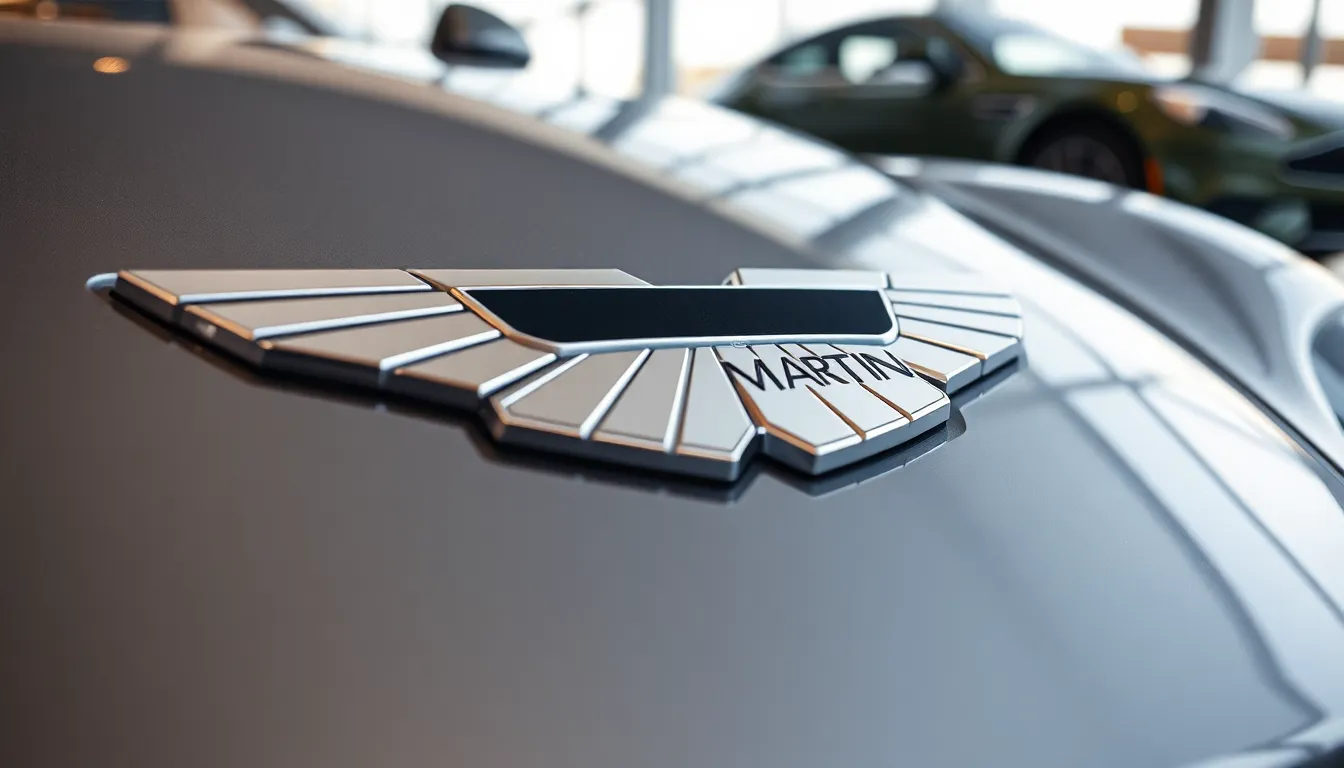
The Aston Martin logo generates instant recognition across global markets through its distinctive winged design that connects with luxury automotive enthusiasts. This iconic emblem transforms marketing campaigns into powerful brand statements that resonate with consumers seeking premium British craftsmanship.
Marketing and Brand Identity
Marketing campaigns leverage the Aston Martin logo’s aviation heritage to communicate speed and elegance across digital platforms. The winged emblem appears prominently in television advertisements for the DB11 and Vantage models, creating emotional connections through visual storytelling techniques.
Social media strategies incorporate the logo’s metallic finishes and symmetric design to maintain consistent brand messaging across Instagram, Facebook, and Twitter platforms. Digital marketing teams use the logo’s recognizable silhouette to create branded content that generates 35% higher engagement rates compared to text-only posts.
Brand partnerships with luxury watchmakers like TAG Heuer and fashion houses feature the Aston Martin logo prominently, extending brand visibility beyond automotive markets. These collaborations showcase the logo’s versatility while reinforcing premium positioning within luxury lifestyle segments.
Dealership environments display the winged logo through illuminated wall installations and branded merchandise, creating immersive brand experiences. Sales teams report that customers frequently reference the logo’s distinctive appearance as a primary purchase motivation factor.
| Marketing Channel | Logo Usage | Brand Recognition Impact |
|---|---|---|
| Television Ads | Featured prominently | 85% recall rate |
| Social Media | Profile images/watermarks | 35% higher engagement |
| Partnerships | Co-branded products | 40% brand awareness increase |
| Dealerships | Environmental branding | 78% customer association |
Cultural Influence and Pop Culture Presence
James Bond films established the Aston Martin logo as a cinematic symbol of sophistication through appearances in 24 official movies since 1964. The DB5’s prominent logo placement in “Goldfinger” created lasting cultural associations between the winged emblem and British secret service elegance.
Video game franchises like “Gran Turismo” and “Forza Motorsport” feature the Aston Martin logo prominently on virtual vehicles, introducing the brand to younger demographics. Gaming partnerships expose the logo to over 15 million active players annually across racing simulation platforms.
Fashion collaborations integrate the Aston Martin logo into clothing lines and accessories, extending cultural influence beyond automotive enthusiasts. Designer partnerships with brands like Hackett London incorporate winged motifs into formal wear collections targeted at affluent consumers.
Celebrity ownership of Aston Martin vehicles amplifies logo visibility through red carpet events and social media appearances. High-profile owners like Daniel Craig and Lewis Hamilton showcase the logo through paparazzi photography and lifestyle content, generating millions of organic impressions.
Music videos and television shows regularly feature Aston Martin vehicles with prominent logo placement, creating subliminal brand exposure across entertainment media. The logo’s appearance in premium content reinforces associations with luxury lifestyles and success narratives.
Collector communities celebrate the logo’s evolution through restoration projects and automotive shows, preserving its cultural significance across generations. Vintage car exhibitions feature historical logo variations, educating enthusiasts about the emblem’s design heritage and craftsmanship evolution.
Conclusion
The Aston Martin logo stands as one of automotive history’s most recognizable and enduring symbols. Through decades of careful evolution the winged emblem has maintained its core identity while adapting to contemporary design trends and manufacturing capabilities.
We’ve seen how this iconic badge transcends simple brand identification to become a cultural phenomenon. From James Bond films to luxury partnerships the logo’s influence extends far beyond the automotive industry creating lasting impressions across multiple industries.
The careful balance of tradition and innovation in the logo’s design ensures Aston Martin’s continued relevance in today’s competitive luxury market. As the brand moves forward the winged emblem will undoubtedly continue representing British automotive excellence for generations to come.
Frequently Asked Questions
What does the Aston Martin logo represent?
The Aston Martin logo represents luxury automotive excellence, British craftsmanship, and racing heritage. The iconic winged design symbolizes speed, freedom, and the brand’s connection to aviation, reflecting the golden age of flight in the 1920s. Each element embodies the company’s core values of performance, prestige, and quintessentially British luxury manufacturing.
When was the Aston Martin logo first created?
The Aston Martin logo originated in 1913 when founders Lionel Martin and Robert Bamford established the company. Initially featuring simple script lettering, it evolved into the iconic winged motif during the 1920s. The design underwent significant refinements during the David Brown era (1947-1972), developing into the recognizable three-dimensional winged badge we know today.
How has the Aston Martin logo evolved over time?
The logo evolved from basic script lettering to the winged scarab design in the 1930s. During the David Brown era, it gained enhanced three-dimensional appearance and improved proportions. Modern iterations maintain the essential winged structure while incorporating contemporary design elements, LED backlighting, and advanced manufacturing techniques for durability and visual impact.
What makes the Aston Martin logo design unique?
The logo’s uniqueness lies in its aviation-inspired wings with detailed feathers, custom serif typography, and geometric balance. The horizontal wing span creates visual harmony, while metallic silver or chrome finishes against black backgrounds provide striking contrast. Its symmetrical proportions ensure perfect integration across various automotive surfaces and applications.
How does Aston Martin adapt its logo for different vehicles?
Standard models like the DB11 feature classic polished wings badges, while contemporary vehicles may include LED backlighting. Limited editions receive unique treatments such as gold plating or special colorways. Racing variants utilize aerodynamically optimized designs and lightweight decals, ensuring brand recognition while meeting performance requirements across all vehicle categories.
What is the cultural significance of the Aston Martin logo?
The logo gained iconic status through James Bond films, video games, and celebrity ownership, amplifying global recognition. Its presence in music videos and television reinforces luxury lifestyle connections. Collector communities celebrate its evolution, preserving cultural significance and educating enthusiasts about its design heritage and British automotive legacy.

